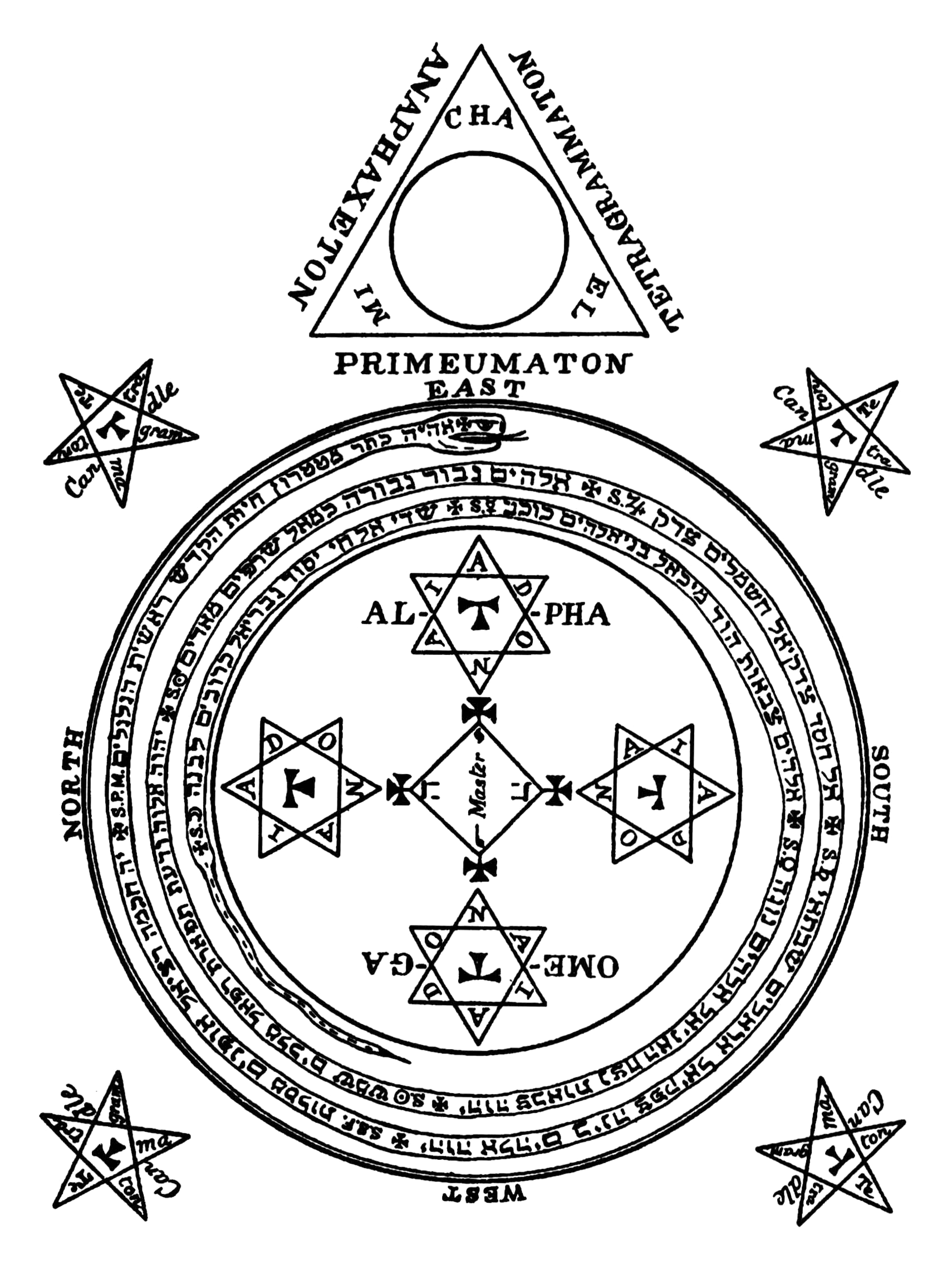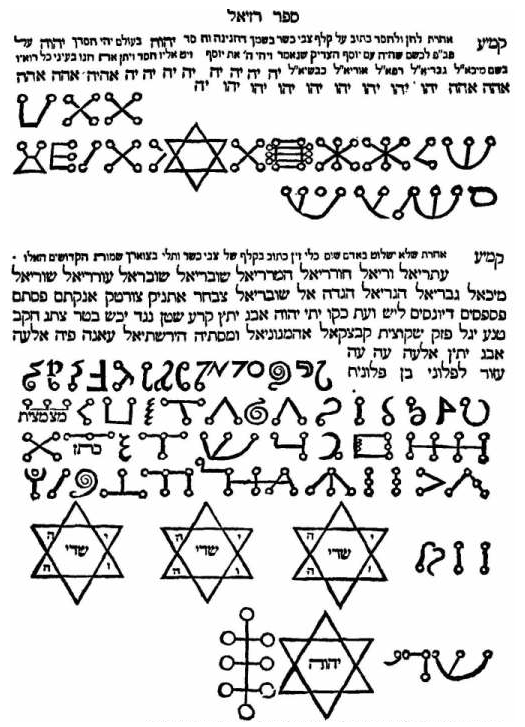|
Semiphoras And Schemhamphorash
''Semiphoras and Schemhamphorash'' (''Semiphoras und Schemhamphoras'') is the title of an occult or magic text of Jewish provenance, published in German by Andreas Luppius in 1686. It was based on the earlier Latin text, ''Liber Semiphoras'' (aka Semamphoras, Semyforas) attributed to Solomon, which Luppius augmented heavily with passages from Agrippa '' De occulta philosophia'' and other sources. It is heavily indebted to Sepher ha-Razim through its Latin versions, ''Liber Sepher Razielis idest Liber Secretorum seu Liber Salomonis'', and seemingly replaced the more explicitly magical text ''Liber magice'' in the Alphonsine ''Razielis''. This book was attested in 1260 by Roger Bacon, and mentioned by the Latin ''Liber Razielis'' (ms VRL 1300 2nd half of 14th ce, 36v). Manuscripts include Kassel, Univ. Bibl., 4° astron (dated 1346, L.1.f.20), Halle ULB 14-B-36, fols. 244-249 (especially fol. 246r – late 15th ce hand), 346, and 377v (16th ce hand). Also CLM 51 (1487, fols. 120v-1 ... [...More Info...] [...Related Items...] OR: [Wikipedia] [Google] [Baidu] |
Johannes Hartlieb
Johannes Hartlieb (c. 1410Hartlieb's year of birth is unknown; his existence is first attested as the author of ''Kunst der Gedächtnüß'', written during 1430–32, and an estimate of his year of birth as either "c. 1400" or "c. 1410" can be found in literature. – 18 May 1468) was a physician of Late Medieval Bavaria, probably of a family from Neuburg an der Donau. He was in the employment of Louis VII of Bavaria and Albert VI of Austria in the 1430s, and of Albert III of Bavaria from 1440, and of the latter's son Sigismund from 1456. In 1444, he married Sibilla, possibly the daughter of Albert and Agnes Bernauer. Hartlieb wrote a compendium on herbs in ca. 1440, and in 1456 the ''puch aller verpoten kunst, ungelaubens und der zaubrey'' (book on all forbidden arts, superstition and sorcery) on the artes magicae, containing the oldest known description of witches' flying ointment. Hartlieb also produced German translations of various classical and medieval authors ( T ... [...More Info...] [...Related Items...] OR: [Wikipedia] [Google] [Baidu] |
1686 Books
Events January–March * January 3 – In Madras (now Chennai) in India, local residents employed by the East India Company threaten to boycott their jobs after corporate administrator William Gyfford imposes a house tax on residences within the city walls. Gyfford places security forces at all entrances to the city and threatens to banish anyone who fails to pay their taxes, as well as to confiscate the goods of merchants who refuse to make sales. A compromise is reached the next day on the amount of the taxes. * January 17 – King Louis XIV of France reports the success of the Edict of Fontainebleau, issued on October 22 against the Protestant Huguenots, and reports that after less than three months, the vast majority of the Huguenot population had left the country. * January 29 – In Guatemala, Spanish Army Captain Melchor Rodríguez Mazariegos leads a campaign to conquer the indigenous Maya people in the rain forests of Lacandona, departing ... [...More Info...] [...Related Items...] OR: [Wikipedia] [Google] [Baidu] |
The Lesser Key Of Solomon
''The Lesser Key of Solomon'', also known as ''Lemegeton Clavicula Salomonis'' or simply ''Lemegeton'', is an anonymous grimoire on demonology. It was compiled in the mid-17th century, mostly from materials a couple of centuries older.''Lemegeton Clavicula Salomonis: The Lesser Key of Solomon, Detailing the Ceremonial Art of Commanding Spirits Both Good and Evil''; ed. Joseph H. Peterson; Weiser Books Maine; 2001. pp. xi–xvii.''The Goetia of Dr Rudd''; Thomas Rudd, Eds. Stephen Skinner & David Rankine; 2007, Golden Hoard Press. p. 399. It is divided into five books—the ''Ars Goetia'', ''Ars Theurgia-Goetia'', ''Ars Paulina'', ''Ars Almadel'', and ''Ars Notoria''. ''Ars Goetia'' Etymology The text is more properly called "Lemegeton Clavicula Salomonis, or, The little Key of Solomon". The title most commonly used, "The Lesser Key of Solomon," does not in fact occur in the manuscripts. A.E. Waite, in his 1898 ''Book of Black Magic and of Pacts'' does use the te ... [...More Info...] [...Related Items...] OR: [Wikipedia] [Google] [Baidu] |
Renaissance Magic
Renaissance magic was a resurgence in Hermeticism and Neo-Platonic varieties of the magical arts which arose along with Renaissance humanism in the 15th and 16th centuries CE. These magical arts (called '' artes magicae'') were divided into seven types. There was great uncertainty in distinguishing practices of superstition, occultism, and perfectly sound scholarly knowledge or pious ritual. The intellectual and spiritual tensions erupted in the Early Modern witch craze, further reinforced by the turmoil of the Protestant Reformation, especially in Germany, England, and Scotland. Artes magicae The seven ''artes magicae'' or ''artes prohibitae'', arts prohibited by canon law, as expounded by Johannes Hartlieb in 1456, their sevenfold partition reflecting that of the artes liberales and artes mechanicae, were: # nigromancy ('black magic', demonolatry) # geomancy # hydromancy # aeromancy # pyromancy # chiromancy # scapulimancy The division between the four "elemental" disc ... [...More Info...] [...Related Items...] OR: [Wikipedia] [Google] [Baidu] |
Arbatel De Magia Veterum
The ''Arbatel De Magia Veterum'' () is a Latin grimoire of Renaissance ceremonial magic published in 1575 in Switzerland.Arbatel De magia veterum (Arbatel: Of the Magic of the Ancients), Anonymous, ed. Joseph Peterson; 1997. Available online aEsoteric Archives/ref>Arbatel: ''Concerning the Magic of the Ancients'', Newly translated, edited and annotated by Joseph H. Peterson, Ibis Press/Nicolas Hays, 2009. pp. IX-XXI Title A. E. Waite assumes that the title is from the (or ''Arbotal'') as the name of an angel the author would have claimed to have learned magic from. Adolf Jacoby believed the name to be a reference to the Tetragrammaton, via the Hebrew ARBOThIM (fourfold) and AL (or God). Peterson, mentioning the above possibilities, also suggests that the title might be the author's pseudonym. Origin The ''Arbatel'' is noted for being straightforward in its writing, positive in its contents, and unusually honest regarding its origins. While a number of occult works claim to ... [...More Info...] [...Related Items...] OR: [Wikipedia] [Google] [Baidu] |
Liber Salomonis
''Sefer Raziel HaMalakh'', (Hebrew:, "the book of Raziel the angel''"''), is a grimoire of Practical Kabbalah from the Middle Ages written primarily in Hebrew and Aramaic. ''Liber Razielis Archangeli'', its 13th-century Latin translation produced under Alfonso X of Castile, survives. Textual history The book cannot be shown to predate the 13th century, but may in parts date back to late antiquity. Like other obscure ancient texts such as the '' Bahir'' and ''Sefer Yetzirah'', the work has been extant in a number of versions. The tradition around the book attributes it to have been revealed to Adam by the angel Raziel. The title itself is mentioned in another magical work of late antiquity, ''The Sword of Moses''. Critical historians regard it as a medieval work, most probably originating among the Ashkenazi Hasidim, as citations from it begin to appear only in the 13th century. Sections of it are no doubt older. The likely compiler of the medieval version is Eleazar of Worms, ... [...More Info...] [...Related Items...] OR: [Wikipedia] [Google] [Baidu] |
Shem HaMephorash
''Shem HaMephorash'' ( he, שֵׁם הַמְּפֹרָשׁ ''Šēm hamMəfōrāš'', also ''Shem ha-Mephorash''), meaning "the explicit name," is originally a Tannaitic term describing the Tetragrammaton. In Kabbalah, it may refer to a name of God composed of either 4, 12, 22, 42, or 72 letters (or triads of letters), the latter version being the most common. 12-, 22-, and 42-letter names Early sources, from the Mishnah to Maimonides, only use "Shem ha-Mephorash" to refer to the four letter Tetragrammaton. b. Qiddushin 72a describes a 12-letter name (apparently a mundane euphemism, YHWH-EHYH-ADNY or YHWH-YHWH-YHWH) and a 42-letter name (holy but unknown; Hayy Gaon says it is the acronym of the medieval piyyut Ana b'Koachתשובה אל יוסף בן ברכיה ותלמידי יעקב בן נסים בעניין שמות והשבעות, קונטרס "הדר עם הנכרי בחצר"). A 22-letter name appears in '' Sefer Raziel HaMalakh'', without interpretation, as ('). It ... [...More Info...] [...Related Items...] OR: [Wikipedia] [Google] [Baidu] |
Kabbalah
Kabbalah ( he, קַבָּלָה ''Qabbālā'', literally "reception, tradition") is an esoteric method, discipline and school of thought in Jewish mysticism. A traditional Kabbalist is called a Mekubbal ( ''Məqūbbāl'' "receiver"). The definition of Kabbalah varies according to the tradition and aims of those following it, from its origin in medieval Judaism to its later adaptations in Western esotericism ( Christian Kabbalah and Hermetic Qabalah). Jewish Kabbalah is a set of esoteric teachings meant to explain the relationship between the unchanging, eternal God—the mysterious '' Ein Sof'' (, ''"The Infinite"'')—and the mortal, finite universe (God's creation). It forms the foundation of mystical religious interpretations within Judaism. Jewish Kabbalists originally developed their own transmission of sacred texts within the realm of Jewish tradition and often use classical Jewish scriptures to explain and demonstrate its mystical teachings. These teachings are h ... [...More Info...] [...Related Items...] OR: [Wikipedia] [Google] [Baidu] |
Grimoire
A grimoire ( ) (also known as a "book of spells" or a "spellbook") is a textbook of magic, typically including instructions on how to create magical objects like talismans and amulets, how to perform magical spells, charms and divination, and how to summon or invoke supernatural entities such as angels, spirits, deities, and demons.Davies (2009:1) In many cases, the books themselves are believed to be imbued with magical powers, although in many cultures, other sacred texts that are not grimoires (such as the Bible) have been believed to have supernatural properties intrinsically. The only contents found in a grimoire would be information on spells, rituals, the preparation of magical tools, and lists of ingredients and their magical correspondences. In this manner, while all ''books on magic'' could be thought of as grimoires, not all ''magical books'' should be thought of as grimoires. While the term ''grimoire'' is originally European—and many Europeans throughout history, ... [...More Info...] [...Related Items...] OR: [Wikipedia] [Google] [Baidu] |
Solomon
Solomon (; , ),, ; ar, سُلَيْمَان, ', , ; el, Σολομών, ; la, Salomon also called Jedidiah ( Hebrew: , Modern: , Tiberian: ''Yăḏīḏăyāh'', "beloved of Yah"), was a monarch of ancient Israel and the son and successor of David, according to the Hebrew Bible and the Old Testament. He is described as having been the penultimate ruler of an amalgamated Israel and Judah. The hypothesized dates of Solomon's reign are 970–931 BCE. After his death, his son and successor Rehoboam would adopt harsh policy towards the northern tribes, eventually leading to the splitting of the Israelites between the Kingdom of Israel in the north and the Kingdom of Judah in the south. Following the split, his patrilineal descendants ruled over Judah alone. The Bible says Solomon built the First Temple in Jerusalem, dedicating the temple to Yahweh, or God in Judaism. Solomon is portrayed as wealthy, wise and powerful, and as one of the 48 Jewish prophets. He is also ... [...More Info...] [...Related Items...] OR: [Wikipedia] [Google] [Baidu] |
Sixth And Seventh Books Of Moses
The ''Sixth and Seventh Books of Moses'' is an 18th- or 19th-century magical text allegedly written by Moses, and passed down as hidden (or lost) books of the Hebrew Bible. Self-described as "the wonderful arts of the old Hebrews, taken from the Mosaic books of the Kabbalah and the Talmud", it is actually a grimoire, or text of magical incantations and seals, that purports to instruct the reader in the spells used to create some of the miracles portrayed in the Bible as well as to grant other forms of good fortune and good health. The work contains reputed Talmudic magic names, words, and ideograms, some written in Hebrew and some with letters from the Latin alphabet. It contains "Seals" or magical drawings accompanied by instructions intended to help the user perform various tasks, from controlling weather or people to contacting the dead or Biblical religious figures. Copies have been traced to 18th-century German pamphlets, but an 1849 printing, aided by the appearance o ... [...More Info...] [...Related Items...] OR: [Wikipedia] [Google] [Baidu] |








